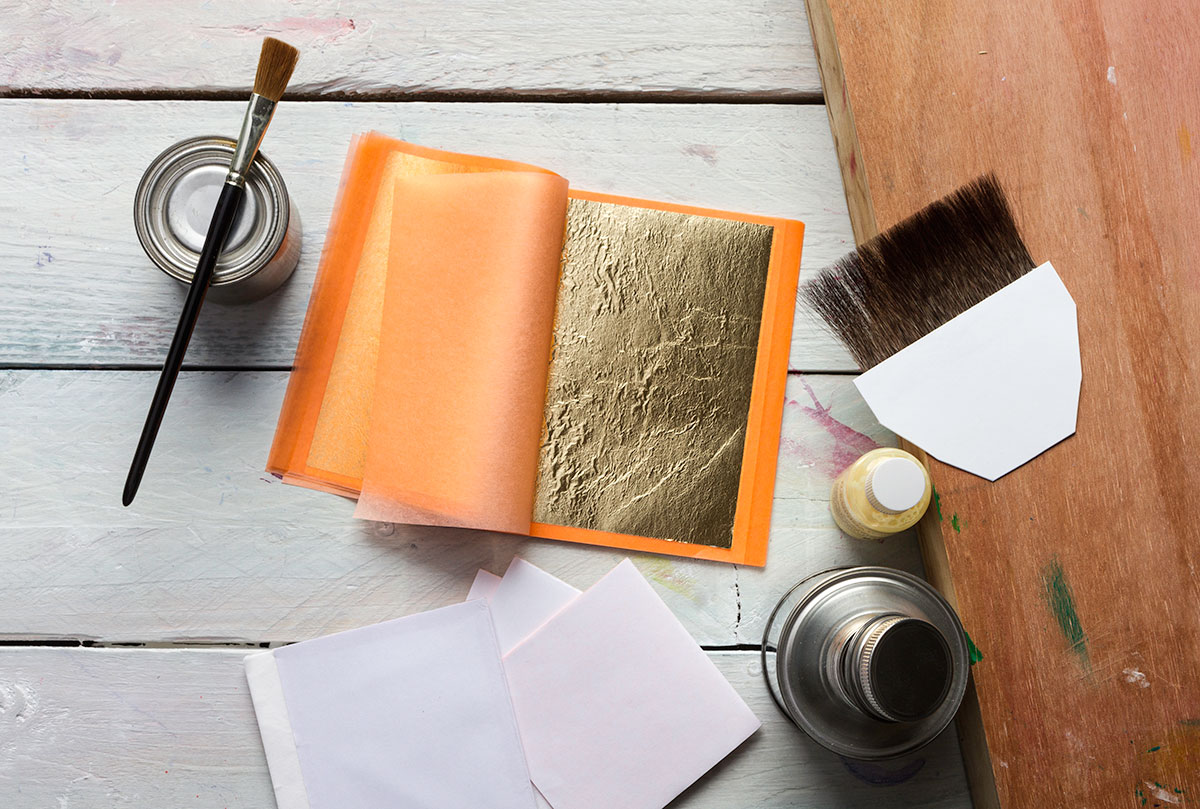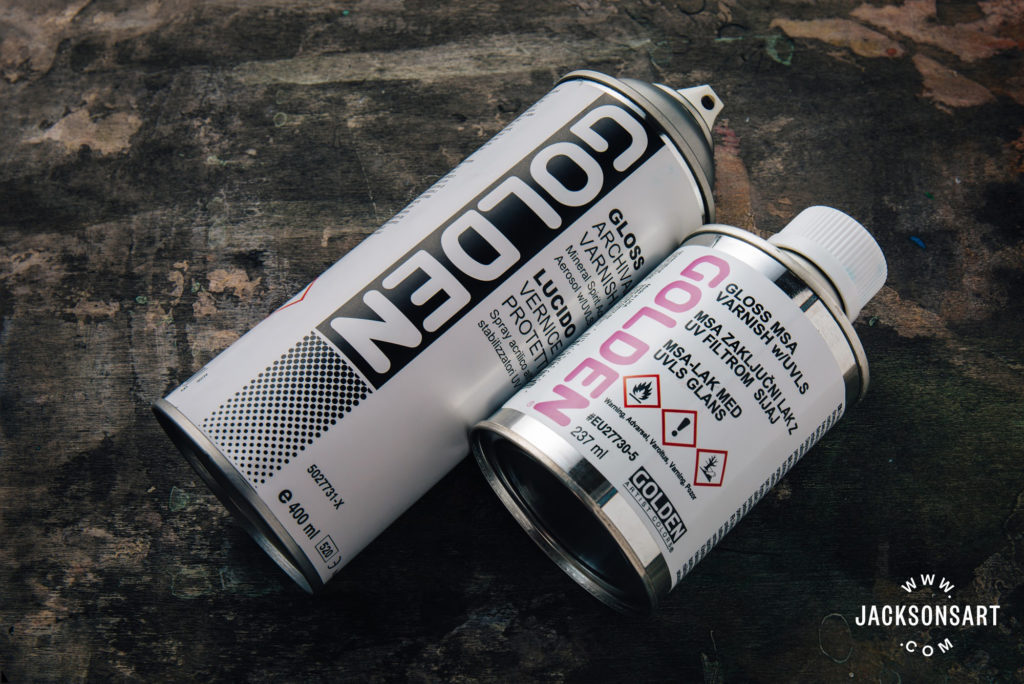Can You Draw on Top of Gold Leaf
A painting in transparent acrylics or oils on top of a panel covered in gold leaf, or another metal leaf, can glow with a shining light. The procedure for painting on top of gold leaf, silver leaf or copper leaf – genuine or imitation metal leaf – is not as complicated as you might think. After you have applied your gilding and let it cure you then apply one or two types of sealer and you are ready to paint.
1.
Be aware that metal leaf is so thin that any texture underneath will show through, so you may wish to prepare the surface of your support to be as smooth as possible. Apply your metal leaf to your support following the directions on your bottle of acrylic gold size or oil-based gold size (that's the adhesive). I use the transfer gold or silver leaf as opposed to the loose metal leaf because it is so much easier to work with and you don't really need the loose leaf unless you are working on a surface with grooves or carving that you need to push it down into. Brush the excess off gently with a soft brush. Rub the gold down firmly through a piece of paper or cloth. Then let it dry thoroughly, usually about three days or the curing time listed on the bottle of gold size, before sealing it in the next step. It needs to have air reach it to finish the curing process and become hard and stable.
2.
Then spray or brush on Golden MSA (Mineral Spirit Acrylic) Gloss Archival Varnish to seal and prime the metal leaf surface for the oil or acrylic paint layer. You should seal all metal leaf because it is thin, delicate and can be scratched, but some metal leaf will also tarnish if you don't seal it. You need to choose a product to seal the tarnish-able leaf that will not itself cause tarnishing. After speaking with a technical expert and testing it ourselves we determined that the Golden MSA varnish is the correct choice for sealing metal leaf without damaging it. Using a gloss varnish allows you to retain the shine of the metal. Three coats of spray varnish or one thin coat of MSA Varnish brushed on should be enough to protect the surface from tarnishing. Read the label for the dilution instructions of the brush-on varnish.
There are two ways that the metal leaf can tarnish. Sealing with the MSA varnish prevents both kinds.
If left unsealed some metals will tarnish over time from exposure to air and some will not:
- Genuine silver leaf will tarnish
- Imitation silver (aluminium) won't tarnish (sometimes it will slowly tarnish if it is not pure aluminium)
- Genuine gold of 22ct or more will not tarnish
- Genuine gold of less than 22ct (gold plus copper – or sometimes silver or another metal) will tarnish
- Imitation gold (copper and zinc) will tarnish
- Genuine copper and imitation copper (copper and zinc) will tarnish.
Acrylic paint and mediums contain ammonia which will tarnish any leaf containing copper. Sealing the metal with the solvent-based varnish before applying acrylics solves this problem. If you are painting in acrylics and are using one of the metals that does not tarnish (genuine gold 22-24ct and genuine or imitation silver) you can skip the varnish sealer and use the acrylic medium coat in the next step instead.

3.
If you are painting over the metal leaf with oil paint you should next apply a coat of GAC 200 or another clear gloss fluid acrylic medium. This will seal the MSA varnish from any future solvent applications.
4.
You are now ready to paint. Lots of artists like the look of bits of shiny metal peeking out of the paint. Remember that transparent colours will allow some of the metal leaf to shine through the colour (especially if painted on thinly or in a glaze), while opaque colours will completely cover over it, and metallic paints will be less shiny than the metal leaf.
5.
If you plan on a final varnish, a gloss varnish will keep the metallic shine the best. You can use the same MSA that you primed with, it works on top of oil or acrylic.

Golden MSA Varnish and Golden Archival Spray Varnish
Summary of sealing the metal leaf
- All metal leaf should be sealed before beginning your painting.
- If painting in acrylic on a leaf with no copper in it (genuine gold 22-24ct, genuine or imitation silver) then you can seal it with a hard clear acrylic polymer medium in gloss.
- If painting in acrylic on a leaf with copper in it (imitation gold, genuine or imitation copper, genuine gold of less than 22ct) you need to seal with MSA varnish before painting.
- If painting on top with oils you need both steps – the MSA varnish to seal the leaf and the polymer medium to seal the varnish from solvents.
Adding more gold leaf on top of paint
- Oil paint takes six months or more to completely dry, so applying metal leaf on top of oil paint is not advised because the adhesive (gold size) will prevent the oil from finishing drying and making a stable structure. It should be fine to add it on top of a very well-dried painting – dry enough that you would varnish it (this could be a year or more if it's thick paint). Be sure to use an oil-based size and test a bit to make sure it adheres. You will need to seal the leaf each time you apply a new layer.
- Adding more metal leaf on top of acrylic paint is fine, but be aware that acrylic needs a few days to cure and let all the volatiles gas-off, so don't add size on top right away, give it a few days so you don't seal the surface too soon. Be sure to use an acrylic-based size and test a bit to make sure it adheres. You will need to seal the leaf each time you apply a new layer.
Links to the materials at Jackson's
- Metal Leaf
- Gold Size
- The Gilding Department
- Golden Acrylic Archival MSA Spray Varnish Gloss
- Golden Acrylic Archival MSA Brush on Varnish (you will need to dilute it, see article below)
- Golden GAC 200
- Gilding books
- Soft brushes
Related Articles
- MSA Varnish Dilution Test Results
- Casting A Spell: Image Making with Screenprint, Linocut and Gold Leaf by Colin Blanchard
- Inspired by Gold: How Alison Woolley uses traditional water gilding techniques in her work
- Metallic Oil Paints with Oil Bronzes
- Interview with artist Greg Ramdsen, who incorporates silver leaf into his landscape paintings
Read More
- Acrylics on Gold Leaf from Just Paint.
- How to Apply Gold Leaf by Nacy Reyner.
This is an updated version of an original post published on 11th January 2011
Julie was the editor of the Jackson's Art Blog for 10 years and now writes for the blog part time. With an encyclopaedic knowledge of art materials (majoring in oils and acrylics), she loves researching and writing pieces for the blog as she learns something new each time. Julie is also a professional artist who studied on the Turps Studio Painting Programme in London and has an MA from Camberwell College of Art.
Can You Draw on Top of Gold Leaf
Source: https://www.jacksonsart.com/blog/2020/05/19/painting-acrylic-on-gold-leaf/
0 Response to "Can You Draw on Top of Gold Leaf"
Post a Comment